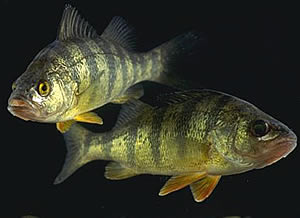
Many studies have focused on fish kills. MSU is conducting the first study on the impact of sublethal poisoning on fish in the Great Lakes.
While the causes and effects of fish kills have been studied repeatedly, the outcomes of poisoning that is less than lethal have not.
Using a $498,334 grant from the Environmental Protection Agency, Michigan State University will lead a team of researchers to study how increasing doses of toxic substances affect yellow perch, a species of economic and ecological importance to the Great Lakes. The study will focus on exposure to mercury, a neurotoxin present in most of the Great Lakes, on the widely popular game fish.
"This is the first time such an exercise has been performed for the Great Lakes ecosystem," said Cheryl Murphy, assistant professor of environmental toxicology. "Contaminants that don't kill fish can still have many negative repercussions on fish populations, and we hope to shed some light on those issues."
Low doses of pollutants, such as mercury, can subtly disrupt key physiological processes related to behavior, growth, survival and reproduction. Murphy's team will test perch with continually increasing levels of toxins. As the levels of poison are increased, the scientists will examine their effects on hormone levels to their impact on overall populations of fish.
The National Research Council recently implored scientists to better assess the risks of environmental chemicals on humans. The NRC also asked that approaches be developed to examine the effects of toxins and to examine their impact across the spectrum from the molecular level to their impacts on individuals as well as entire population levels.
Murphy's work takes the spirit of NRC's recommendation and applies it to fish. This new testing protocol will help change the status quo for assessing potential threats to aquatic life, she said.
"We purposely designed our platform as a framework that can be used to test for other contaminants or study other species of fish," Murphy said. "We are hopeful that our project helps set the standard for the National Research Council's principles on toxicity testing in the 21st century."
Scientists from the University of Michigan and the University of Wisconsin-Milwaukee are part of the research team.
The grant is part of the EPA's Great Lakes Restoration Initiative, a $475 million plan that calls for aggressive efforts to address the cleanup of toxins, combat invasive species, promote near shore health and restore wetlands and other habitats. Overall, MSU researchers have been awarded more than $3 million for seven projects as part of the initiative. For more information on the EPA's efforts, visit www.greatlakesrestoration.us.
